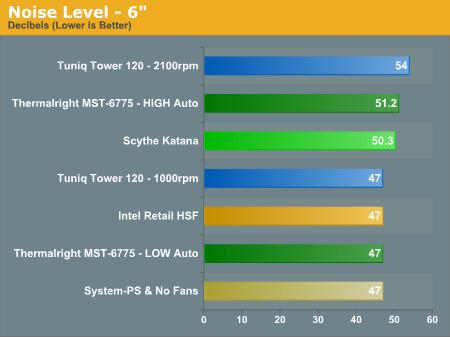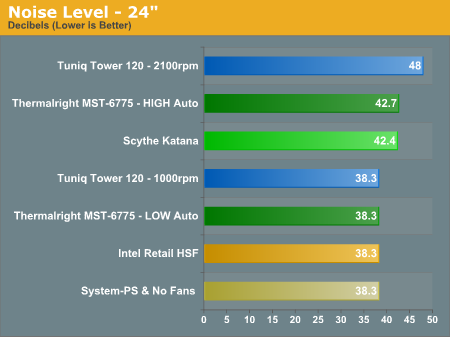Value Cooling: Two Towers for under $30
by Wesley Fink on January 23, 2007 3:50 AM EST- Posted in
- Cases/Cooling/PSUs
Noise
For some users the goal is maximum stable overclock, and they will live with the inconvenience of a louder system. For others silence is the most important factor, and these users will forgo overclocking if this increases system noise levels. Both the Thermalright MST-9775 and the Scythe Katana use 92mm fans running at a relatively slow 2000rpm to reduce noise while still maintaining high air flow for cooling. This is a particularly large fan for cooling solutions aimed at the value end of the cooler market.
In addition, the 4 pin fan connector used by the MST-9775 allows the system to automatically vary fan speed based on CPU temperature. In testing we found the variation between the Auto low and high speeds to be around 1000rpm on low and 2000rpm on high speed. As a result of the variable fan speed results at both low and high fan speeds were measured and reported for the Thermalright.
There are virtually no power supplies that do not have a fan. While Zalman and a few others do make a few expensive fanless power supplies, we are not aware of one that is larger than 500W, or that would be used for seriously overclocking a system. With that in mind the noise level of the system with all fans turned off except the Power Supply was measured. The power supply used for the cooling test bed was the OCZ PowerStream 520, which is one of the quieter high performance power supplies. The noise level of the Power Supply was 38.3db from 24" (61cm) and 47db from 6" (152mm). The measured noise level of the test room is 36.4db, which would be considered a relatively quiet room with a noise floor below the OCZ PowerStream 520 PSU.
Keep in perspective that the dB scale is logarithmic and not linear, so a 3dB increase represents a doubling of sound power. Some studies suggest that while the human ear can discern small differences in sound level, the human ear perceives a doubling of loudness at a 10dB increase. Others quote double the sound level perception as 6db.


Measured noise levels in this chart should be considered worst case. Measurements were taken with an open side of a mid tower case 6" from the HSF and 24" from the HSF. Real world would be a completely closed case with a further reduction in noise.
Subjectively the Scythe and Thermalright were both quiet at the standard fan speed of 2000rpm. However, neither cooler was really as quiet as a stock Intel HSF. The increase in noise will be hardly noticed by most users since the noise increase is small and the noise frequency is not particularly irritating.
When the Thermalright MST-9775 drops to low speed on Auto the measured noise is below the system noise floor. If minimum noise is your goal, a fan speed controller could easily be added to the Katana or the MST-9775 to keep noise levels below the system floor. We found just below top speed - about 1800rpm - dropped measured noise below the system floor.
For some users the goal is maximum stable overclock, and they will live with the inconvenience of a louder system. For others silence is the most important factor, and these users will forgo overclocking if this increases system noise levels. Both the Thermalright MST-9775 and the Scythe Katana use 92mm fans running at a relatively slow 2000rpm to reduce noise while still maintaining high air flow for cooling. This is a particularly large fan for cooling solutions aimed at the value end of the cooler market.
In addition, the 4 pin fan connector used by the MST-9775 allows the system to automatically vary fan speed based on CPU temperature. In testing we found the variation between the Auto low and high speeds to be around 1000rpm on low and 2000rpm on high speed. As a result of the variable fan speed results at both low and high fan speeds were measured and reported for the Thermalright.
There are virtually no power supplies that do not have a fan. While Zalman and a few others do make a few expensive fanless power supplies, we are not aware of one that is larger than 500W, or that would be used for seriously overclocking a system. With that in mind the noise level of the system with all fans turned off except the Power Supply was measured. The power supply used for the cooling test bed was the OCZ PowerStream 520, which is one of the quieter high performance power supplies. The noise level of the Power Supply was 38.3db from 24" (61cm) and 47db from 6" (152mm). The measured noise level of the test room is 36.4db, which would be considered a relatively quiet room with a noise floor below the OCZ PowerStream 520 PSU.
Keep in perspective that the dB scale is logarithmic and not linear, so a 3dB increase represents a doubling of sound power. Some studies suggest that while the human ear can discern small differences in sound level, the human ear perceives a doubling of loudness at a 10dB increase. Others quote double the sound level perception as 6db.


Measured noise levels in this chart should be considered worst case. Measurements were taken with an open side of a mid tower case 6" from the HSF and 24" from the HSF. Real world would be a completely closed case with a further reduction in noise.
Subjectively the Scythe and Thermalright were both quiet at the standard fan speed of 2000rpm. However, neither cooler was really as quiet as a stock Intel HSF. The increase in noise will be hardly noticed by most users since the noise increase is small and the noise frequency is not particularly irritating.
When the Thermalright MST-9775 drops to low speed on Auto the measured noise is below the system noise floor. If minimum noise is your goal, a fan speed controller could easily be added to the Katana or the MST-9775 to keep noise levels below the system floor. We found just below top speed - about 1800rpm - dropped measured noise below the system floor.










28 Comments
View All Comments
takumsawsherman - Wednesday, January 24, 2007 - link
Why is the Tuniq tower 120 being compared against much cheaper coolers with smaller fans? Why not pit it against the Thermalright HR-01, which would be more of an apples to apples comparison?I am sure that Scythe must have a more worthy competitor as well, though I am not familiar with their line.
LoneWolf15 - Thursday, January 25, 2007 - link
Scythe's Infinity is probably the closest competitor. I believe there may be a few other sites that have reviewed it.
Wesley Fink - Wednesday, January 24, 2007 - link
You neglected to mention that we also compared the performance of the Scythe Katana and Thermalright MST-9775 to the Intel Retail HSF that comes with the Core 2 Duo processor. Until we test a cooler that might perform better than the Tuniq the range of performance is "real-world" between the Intel Retail HSF and the Tuniq. We believe most readers want to know how a tested cooler compares in this rnage - so they can decide if the features or cost are worth the performance drop from the best we have tested.In the future we will be testing some new tower coolers that should challenge the Tuniq. We also plan a value cooler roundup of coolers under $30.
Zoomer - Wednesday, January 24, 2007 - link
Seconded!I'm looking forward to seeing the Arctic Cooler 7 Pro review. In cooler climates with a core2 duo, there is really no need to spend the extra $30 for a huge tower heatsink.
Calin - Wednesday, January 24, 2007 - link
The comparison was between the baseline (the included cooler) and the best air cooler there is (at least known/proven until now).Should the Tuniq Tower be compared to the best air cooled equipments out there? Yes, and it would be nice to compare it to a not very expensive water cooled system too.
Jodiuh - Wednesday, January 24, 2007 - link
Well if that's not reason enough to get a Tuniq.LoneWolf15 - Wednesday, January 24, 2007 - link
Getting one dropped my temps from my old Swiftech by 5-8C when idle and 8-15C under load.It sure was a good enough reason for me. And that's with the fan at a quiet 1400rpm.
And I agree (with what I think you're saying) that, if you're going to spend $30 for an aftermarket cooler, and the Tuniq will fit, why not spend an extra 20-25 for best aftermarket cooler you can get?
Avalon - Tuesday, January 23, 2007 - link
I think it's a good addition to AT to include cooling reviews. However, you guys should see if you can expand temperature gauging a little more to also include PWM temps and other important temperatures, as some HSF solutions have a large affect on these, while others don't.Also, really want to see the Coolermaster Hyper TX in the next roundup!
Vidmar - Tuesday, January 23, 2007 - link
What was the orientation of the CPU/heatsink during the tests? Was the case (and MB) in a horizontal or vertical orientation? Since these new coolers use heatpipes and since the heatpipe technology relies on a liquid that turns to gas when heated then back to liquid when cool, the orientation of the heatsink/heatpipe plays a huge role in how the well it will perform.I would like to think that you are running these tests with the case in a vertical orientation like what a large portion of your readers would be using. But since you never say we don’t know. If these tests are being conducted with the case in a horizontal orientation (laying flat on a table), I would expect that the results would be different than what people would get at home (mostly vertical).
Thanks!
Wesley Fink - Tuesday, January 23, 2007 - link
Noise measurements were run with the case horizontal and an open side. Cooling tests were run with the case in the standard upright position, as our readers will most likely use them at home.